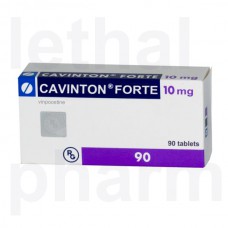Expiration date: 02/2028
Active substance: Vinpocetine.
Structure and Composition:
Tablets. One tablet contains 5 or 10 mg vinpocetine
Other ingredients: colloidal silicon dioxide, magnesium stearate, talc, starch, lactose monohydrate
Concentrate for solution for infusion. One vial contains vinpocetine 10 mg
Excipients: ascorbic acid, sodium bisulfite tartaric acid, benzyl alcohol, sorbitol, water for injections
in ampoules of 2, 5 or 10 ml in blisters 5 ampoules in a cardboard pack 1 or 2 packaging.
Description pharmaceutical form:
Tablets: White or almost white, flat, round tablets with bevelled, odorless, engraved with «CAVINTON», on the one side and on the other, without engraving.
Injection: colorless or slightly greenish, clear solution.
Pharmachologic effect:
Selectively enhances cerebral blood flow and microcirculation, improves the supply of oxygen to the brain. Providing neuroprotection, cerebral hypoxia enhances portability by activating aerobic glucose utilization and metabolism of epinephrine and serotonin in the brain tissues. It improves oxygen transport to the tissues. Reduces the aggregation of platelets and increased blood viscosity, increases the plasticity of erythrocytes.
Description of the pharmacological actions:
Selectively improves blood flow to the brain, reducing the resistance of the blood vessels spasm, which prevents the "steal" phenomenon (normalizes blood supply to the ischemic region). It improves microcirculation and hemorheological parameters. It enhances glucose disposal brain tissue and supply it with oxygen.
Testimony:
In neurology - acute and chronic cerebrovascular insufficiency (transient ischemia, progressing stroke, post-stroke, vascular dementia, atherosclerosis, cerebral vascular, traumatic and hypertensive encephalopathy, vertebrobasilar insufficiency) mental and neurological disorders in patients with cerebrovascular insufficiency (including memory impairment, dizziness, headache, aphasia, apraxia, motor disorders).
In ophthalmology - vascular eye diseases (arteriosclerosis, vasospasm choroid and retina, degenerative diseases of the choroid, retina or macula, arterial and venous thrombosis or embolism, secondary glaucoma).
In ENT practice - hearing loss (vascular, toxic or age genesis), Meniere's disease, kohleovestibulyarny neuritis, tinnitus, vertigo (labyrinthine origin) vasovegetative climacteric syndrome.
Contraindications:
Hypersensitivity, severe coronary artery disease and severe arrhythmia (for parenteral use), pregnancy, breastfeeding.
Application of pregnancy and breastfeeding:
Contraindicated during pregnancy. Data on the safety during breast-feeding are not available.
Side effect:
A transient decrease in blood pressure, tachycardia.
Drug Interactions:
Against the background of parenteral administration of heparin increased the risk of bleeding.
Dosage and administration:
Tablets: inwards after eating, in most cases - 5-10 mg 3 times per day (15-30 mg per day).
Injection: introduced only in / in drip slowly (maximum infusion rate of 80 drops / min). The initial daily dose is 20 mg (2 capsules), diluted in 500 ml infusion solution. Depending on the tolerance dose for 2-3 days can be increased to 1 mg / kg body weight per day.
The course of treatment lasts for an average of 10-14 days, a common daily dose of 70 per kg body weight is 50 mg per day (5 500 mL ampoules of infusion solution). In patients with liver or kidney diseases need no change in dosing.
It is not allowed in the / m and jet / in the introduction of the drug.
After completion of infusion therapy is recommended to continue treatment - 10 mg orally 3 times a day.
To prepare the infusion solutions may be used all glucose solutions or electrolytes (such as Ringer's solution, and Salsol, Rindeks, Reomakrodeks).
Precautionary measures:
In hemorrhagic cerebral stroke parenteral application is admissible only after the disappearance of acute effects (usually 5-7 days).








